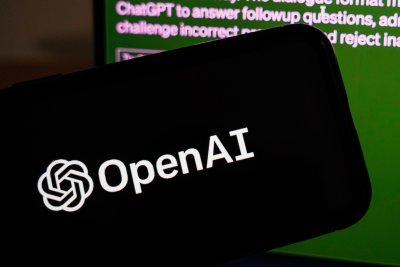Three jobs most at risk of being taken over by AI as 100,000 bots to enter workforce by next year
THE three jobs most at risk of being taken over by AI have been revealed.
British workers will be forced to compete with a surge of 100,000 virtual AI employees by the end of 2026, research by Agentic AI firm Gravitee has suggested.
Software engineers, HR managers and customer service managers appear to be most at risk.
Almost half of company executives surveyed by Gravitee said more than half the work of these roles could be done by an AI agent.
It means companies could cut these jobs to slash business costs.
The other jobs at risk include salesperson, marketing manager and communications manager.
The AI firm surveyed 250 executives at large UK companies and all said they were planning to use AI agents in some way.
Most of the companies said they would ’employ’ between 16 to 20 AI agents to carry out tasks previously carried out by human employees.
Meanwhile 65% of the firms said they would be making job cuts over the same period, suggesting much of the work done by their current employees could be performed more cheaply by AI bots.
Still, nearly a quarter of companies said they plan to increase their headcounts to support the AI expansion.
Rory Blundell, chief executive at Gravitee, said: “Agentic AI will offer a huge productivity boom to firms of all sizes, with AI agents completing rote, repetitive tasks while workers are freed up to focus on more interesting challenges.
“However it’s clear that, at least in the short term, there’s a risk of widespread job cuts until companies know how to balance the investment with the return, which may be shortsighted. Not least because AI Agents, without proper governance, can cause widespread chaos and disruption.”
A report by the International Monetary Fund (IMF) has warned that AI could hit three in five workers and even replace their jobs.
Companies and even the government have already begun to slash their workforce to make way for the technology.
The UK’s biggest accountancy firms – PwC, Deloitte, KPMG and EY – have reportedly slashed the number of junior roles available by up to 29 per cent, while the government is axing at least 10,000 roles in the civil service.
Amazon, Telstra, Salesforce and Fiverr have all announced plans for lay-offs in the last 12 months, with jobs going instead to AI agents.
There were 315,550 available entry-level roles in November 2022 (when the popular AI tool ChatGPT was launched) across the UK, which dropped to 214,934 last month, according to the jobs site Adzuna.
The 40 roles most at risk
Similar research has previously been carried out by Microsoft, which revealed the 40 jobs most likely to be taken over by AI.
Researchers looked at 200,000 conversations between people in the US and Microsoft’s AI chatbot, called Copilot, as part of the study.
They found that the jobs most likely to be affected by AI are those in the communications industry.
Interpreters and translators are the jobs most at risk, followed by historians, and passenger attendants such as air hosts and hostesses or train ticket inspectors.
Sales representatives came fourth on the list, then writers and authors, and customer service representatives.
Other jobs on the list included radio DJs, concierge workers, teachers, public relations specialists and telephone operators.
Jobs that involve physically working with people, operating or monitoring machinery, or doing manual labour tend to be the least-impacted by AI.
This includes nursing assistants, sewage workers, painters and plasterers, roofers, cleaners, and massage therapists.
The jobs most and least at risk from AI
THESE are the professions MOST at risk from AI:
- Interpreters and translators
- Historians
- Passenger attendants
- Sales representatives of services
- Writers and authors
- Customer service representatives
- CNC tool programmers
- Telephone operators
- Ticket agents and travel clerks
- Broadcast announcers and radio DJs
- Brokerage clerks
- Farm and home management educators
- Telemarketers
- Concierges
- Political scientists
- News analysts, reporters, journalists
- Mathematicians
- Technical writers
- Proofreaders and copy markers
- Hosts and hostesses
- Editors
- Postsecondary business teachers
- Public relations specialists
- Demonstrators and product promoters
- Advertising sales agents
- New accounts clerks
- Statistical assistants
- Counter and rental clerks
- Data scientists
- Personal financial advisors
- Archivists
- Postsecondary economics teachers
- Web developers
- Management analysts
- Geographers
- Models
- Market research analysts
- Public safety telecommunicators
- Switchboard operators
- Postsecondary library science teachers
AND these are the professions that are safest from the risks of AI:
- Dredge operators
- Bridge and lock tenders
- Water treatment plant and system operators
- Foundry mold and coremakers
- Rail-track laying and maintenance equipment operators
- Pile driver operators
- Floor sanders and finishers
- Orderlies
- Motorboat operators
- Logging equipment operators
- Paving, surfacing, and tamping equipment operators
- Maids and housekeeping cleaners
- Roustabouts (oil and gas)
- Roofers
- Gas compressor and gas pumping station operators
- Helpers–roofers
- Tire builders
- Surgical assistants
- Massage therapists
- Ophthalmic medical technicians
- Industrial truck and tractor operators
- Supervisors of firefighters
- Cement masons and concrete finishers
- Dishwashers
- Machine feeders and offbearers
- Packaging and filling machine operators
- Medical equipment preparers
- Highway maintenance workers
- Helpers–production workers
- Prosthodontists
- Tire repairers and changers
- Ship engineers
- Automotive glass installers and repairers
- Oral and maxillofacial surgeons
- Plant and system operators (all other)
- Embalmers
- Helpers–painters, plasterers, and similar
- Hazardous materials removal workers
- Nursing assistants
- Phlebotomists



